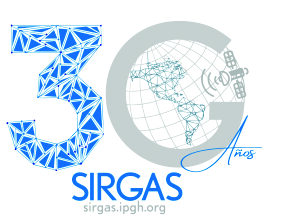SIRGAS-WGIII (Vertical datum) was established during the IAG Scientific Assembly held in Rio de Janeiro in 1997. Its main objectives are to define a modern unified vertical reference system for SIRGAS, to establish the corresponding reference frame, and to transform the existing classical height datums to the new system. As a fundamental SIRGAS-WGIII activity a diagnostic of the existing height datum was carried out, the main conclusions are:
- The reference level of the American height datums is realized by the mean sea level registered at individual tide gauges over different periods, i.e. they refer to different epochs,
- The vertical networks were extended over each country using mainly spirit levelling methods, but in general the levelled heights have not been corrected by the gravity effects,
- They do not take into account the variation of heights and reference levels with time, i.e. they are static, and therefore
- These vertical datums present big discrepancies between neighbouring countries, they do not permit data exchange neither in continental nor in global scale, and they are not able to support practical height determination with GNSS techniques in combination with precise geoid models.
The definition of the new SIRGAS vertical reference system is identical with the definition of the International Height Reference System (IHRS) given by the Resolution No. 1, 2015, of the International Association of Geodesy (IAG). The realization of the new SIRGAS vertical reference system must be a regional densification of the International Height Reference Frame (IHRF). The geometrical component corresponds to ellipsoidal heights referred to the SIRGAS reference frame. The physical component is given in terms of geopotential quantities (W0 as a reference level and geopotential numbers as primary coordinates), and its realization should:
- Refer to the conventional W0 value adopted by Resolution No. 1, 2015 of the IAG,
- Be given by proper physical heights (derived from spirit levelling in combination with gravity reductions or by gravity field analysis of high-resolution), and
- Be associated to a specific reference epoch, i.e. it should consider the coordinate and referential changes with time.
Members of the SIRGAS-WGIII
Gabriel do Nascimento Guimarães (gabriel@ufu.br), president, UFU, Brasil
Ayelen Pereira (apereira@fceia.unr.edu.ar), geopotencial models coordinator, UNR, Argentina
Ezequiel Antokoletz (ezequiel.antokoletz@bkg.bund.de), gravimetric network coordinator, BKG, Germany
Ana Cristina O. C. de Matos (acocmatos@gmail.com), geoid models coordinator, CENEGEO, Brazil
José Luis Carrión Sánchez (josecarrionsa@gmail.com), coordinator spirit-levelling networks, IGM, Ecuador
Agustín Gómez (agusgomez@fcaglp.unlp.edu.ar), UNLP, Argentina
Lucrecia Galván (galvanlucrecia@gmail.com), UNSE, Argentina
Claudia Infante (claudia.nfnt@gmail.com), UNSE, Argentina
Juan Francisco Moirano (jmoirano@fcaglp.unlp.edu.ar), UNLP, Argentina
Claudia Tocho (ctocho@yahoo.com.ar), UNLP, Argentina
Sílvio Rogério Correia de Freitas (sfreitas@ufpr.br), UFPR, Brazil
Karoline Paes Jamur (karoljamur@gmail.com), UFPE, Brazil
Regiane Dalazoana (regiane@ufpr.br), UFPR, Brazil
Denizar Blitzkow (dblitzko@usp.br), USP/CENEGEO, Brazil
Roberto Teixeira Luz (roberto.luz@ibge.gov.br), IBGE, Brazil
Marc Véronneau (marc.veronneau@canada.ca), NRCan, Canada
Jose Tarrío (jose.tarrio@usach.cl), USACH, Chile
Henry Montecino Castro (henrymontecino@gmail.com), UdeC, Chile
Sergio Rozas Bornes (sirgas@igm.cl), IGM, Chile
María Marta Mora Rivas (mmorar@rnp.go.cr), IGN, Costa Rica
Álvaro Álvarez Calderón (aalvarez.igncr@gmail.com), IGN, Costa Rica
Mauricio Varela Sanchez (mauricio.varelasanchez@ucr.ac.cr), UCR, Costa Rica
Leidy Johanna Moisés Sepúlveda (leidydumoises@hotmail.com), IGAC, Colombia
Siervo William León Callejas (swleon@igac.gov.co), IGAC, Colombia
Fredy Cristóbal Flores Estrella (fredy.flores@geograficomilitar.gob.ec), IGM, Ecuador
Ana Isela Vidal Vega (anavidal@uas.edu.mx), UAS, México
Xiaopeng Li (xiaopeng.li@noaa.gov), NOAA, United States
Javier A. Cornejo (jcornejo@anati.gob.pa), IGN, Panama
Rogger Montoya Morray (rmontoyaign02@gmail.com), IGN, Peru
José Leandro Santos (l.santos@ign.gob.do), IGN, Republica Dominicana
Walter Subiza (walter.subiza.pina@igm.gub.uy), IGM, Uruguay
Oscar Carranco (oscar.carranco@mail.igm.gob.ec), IGM, Uruguay
Nilbeny Cano Finil (nilbecf20@gmail.com), IGVSB, Venezuela
Melvin Hoyer (melvinhoyer@gmail.com), LUZ, Venezuela
Napoleón Hernandez (josenapoleonhernandez@gmail.com), IGVSB, Venezuela
Salomão Soares (salomao.soares @ ibge.gov.br), IBGE, Brasil
Nilton de Souza Ribas Junior (nilton.junior @ ibge.gov.br), IBGE, Brasil
Hernan Jose Guerra Trigo (trigo.guerra.hernan@gmail.com), IGM, Bolivia
Past chairs
Silvio Rogério Correia de Freitas (2013 – 2019), UFPR, Brazil
Roberto Texeira Luz (2008 – 2013), IBGE, Brazil
William Martínez Díaz (2007 – 2008), IGAC, Colombia
Laura Sánchez (2001 – 2007), IGAC/DGFI, Colombia/Germany
Roberto Texeira Luz (1997 – 2001), IBGE, Brazil
